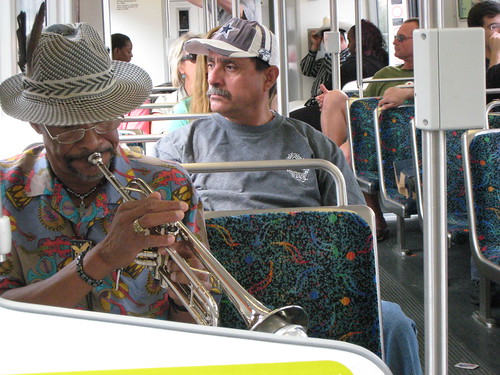In the year
2012 A.D. highway dynamics appears to be a result of individual drivers simply
trying to minimize their travel time and drive in a way that only benefits them.
This is known as User Equilibrium solution, because it creates a
condition on the roadway that stabilizes to a point where every user achieves
about the same efficiency, with nobody receiving an unfair advantage. If some
users are willing to let others cut in front of them or allow others to take a
faster route, these maneuvers could result in an overall increase in travel time
for the local highway network. If all vehicles follow rules to overall reduce
the travel time on the highway, this is described as a System Optimal solution
to the highways. It should be of no surprise that a system optimal scenario rarely happens on roadways. This will hopefully change!
I bring up
these two types of traffic dynamics because the other day, on my bike ride home,
I saw a situation on the highway that deeply bothered me as an extreme example of
User Equilibrium case of traffic. The situation on the highway was this:
A car was stopped in one of the
middle lanes of the highway while backed up cars behind it were just driving around it to continue
on their journey. A picture of this event was captured, see below.
It made me
think that if there were all pedestrians walking, that a fellow human being
would stop and assist the person blocked in the middle of the street/sidewalk.
Bicyclist too, I would
assume, help out a fellow rider. But instead, in a car, we all have enclosed boxes around
us that help us ignore our surroundings and other ‘future friends’ who maybe in
need of some assistance.

A helping
hand in this type of situation wouldn’t only be generous of time and talent,
but it would also help clear the roadway of the traffic slowing down miles of
cars upstream. A few minutes helping the jammed car (and scared/frustrated
driver) could save hundreds of minutes or more on their commute home! It’s as if the protocol for a ‘citizens arrest’ were applicable
for a highway collision here, except it would be called a ‘citizens AAA
rescue’. A few blocked lanes, a couple dedicated drivers willing to help,
should be able to assist the driver to the side of the road for safety and in
an effort to speed up the capacity of the roadway within a matter of a few
minutes. The technical details of how drivers would block all lanes, and
convince other drivers to hold their horses is
still a mystery and safety issue, but solving that would greatly enhance the
roadway conditions during a breakdown.
The
efficiency of the highway in this situation was greatly reduced to its
optimal/maximum throughput, and spending a few minutes to fix the heart of the problem would increase safety and reduce travel time for
travelers. It’s soo evolutionary to be like ant’s and just go around the
problem, even though it’s causing major delays for everyone behind them.
I want to
diverge a bit and continue on the above mentioned thought about cars isolating
people and putting them in boxes. A singled passenger in a car creates a little
bubble for drivers that distances them from the outside world and fellow
travelers. Of all the damage that a car does, I feel this is
by far the worst! It’s not necessarily an effect to be seen over night, but
rather one that happens over a long period of time. This distancing effect is
also prelvant in other areas of our
lives. Scary, yes! While convertibles or Limousines, may seem to help the problem, they only provide a drop in the
bucket solution to this larger problem at hand. So how do we really take the
issue? Here are a few of off-the-cuff ideas to mix things up:
- ·
Roll
down your windows and wave to people when driving. Smile and startconversations with people at red lights.
Now back to
the main issue in this post, transit operations have a slew of dedicated
professional monitoring the transit network, and yet vehicles have nothing of
the sort to help clear the highways. If a monitoring system (or crowd sourced solution) on the highways could help
dispatch a tow truck to a driver in need to help solve a slowdown, the freeways
would operate at a higher capacity and people would be more likely to drive on the same route again tomorrow!
Hopefully
we can develop a solution and take action before we pass another stranded car in the middle of the road,
or a person needing help on the side of the highway.




0 comments:
Post a Comment